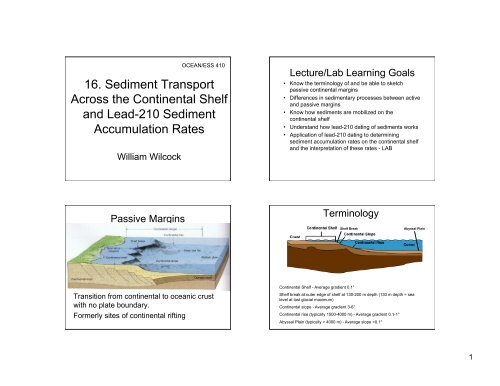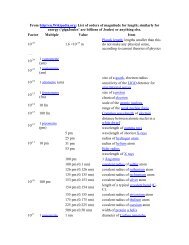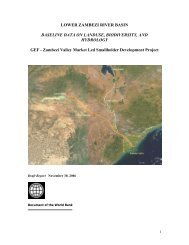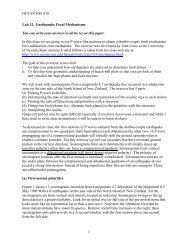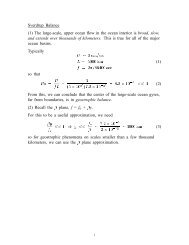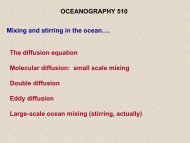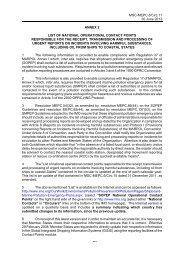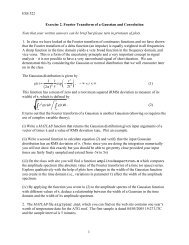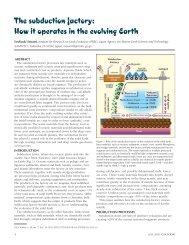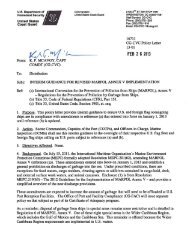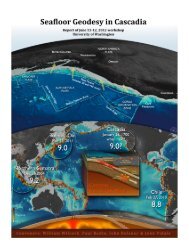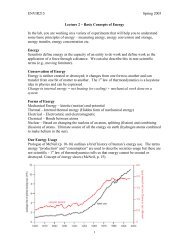16. Sediment Transport Across the Continental Shelf and Lead-210 ...
16. Sediment Transport Across the Continental Shelf and Lead-210 ...
16. Sediment Transport Across the Continental Shelf and Lead-210 ...
You also want an ePaper? Increase the reach of your titles
YUMPU automatically turns print PDFs into web optimized ePapers that Google loves.
<strong>16.</strong> <strong>Sediment</strong> <strong>Transport</strong><br />
<strong>Across</strong> <strong>the</strong> <strong>Continental</strong> <strong>Shelf</strong><br />
<strong>and</strong> <strong>Lead</strong>-<strong>210</strong> <strong>Sediment</strong><br />
Accumulation Rates<br />
William Wilcock<br />
OCEAN/ESS 410<br />
Lecture/Lab Learning Goals<br />
• Know <strong>the</strong> terminology of <strong>and</strong> be able to sketch<br />
passive continental margins<br />
• Differences in sedimentary processes between active<br />
<strong>and</strong> passive margins<br />
• Know how sediments are mobilized on <strong>the</strong><br />
continental shelf<br />
• Underst<strong>and</strong> how lead-<strong>210</strong> dating of sediments works<br />
• Application of lead-<strong>210</strong> dating to determining<br />
sediment accumulation rates on <strong>the</strong> continental shelf<br />
<strong>and</strong> <strong>the</strong> interpretation of <strong>the</strong>se rates - LAB<br />
Passive Margins<br />
Terminology<br />
<strong>Shelf</strong> Break<br />
Abyssal Plain<br />
Transition from continental to oceanic crust<br />
with no plate boundary.<br />
Formerly sites of continental rifting<br />
<strong>Continental</strong> <strong>Shelf</strong> - Average gradient 0.1°<br />
<strong>Shelf</strong> break at outer edge of shelf at 130-200 m depth (130 m depth = sea<br />
level at last glacial maximum)<br />
<strong>Continental</strong> slope - Average gradient 3-6°<br />
<strong>Continental</strong> rise (typically 1500-4000 m) - Average gradient 0.1-1°<br />
Abyssal Plain (typically > 4000 m) - Average slope
Active Margins<br />
<strong>Sediment</strong> transport differences<br />
Plate boundary (usually convergent)<br />
Narrower continental shelf<br />
Plate boundary can move on geological time<br />
scales - accretion of terrains, accretionary prisms<br />
Active margins - narrower shelf, typically have a higher sediment supply,<br />
earthquakes destabilize steep slopes.<br />
<strong>Sediment</strong> Supply to <strong>Continental</strong> <strong>Shelf</strong><br />
• Rivers<br />
• Glaciers<br />
• Coastal Erosion<br />
<strong>Sediment</strong> Mobilization - 1. Waves<br />
<strong>Sediment</strong> <strong>Transport</strong> across <strong>the</strong> <strong>Shelf</strong><br />
Once sediments settle on <strong>the</strong> seafloor, bottom<br />
currents are required to mobilize <strong>the</strong>m.<br />
• Wave motions<br />
• Ocean currents<br />
The wave base or maximum depth of wave motions is about one half <strong>the</strong><br />
wave length<br />
2
Shallow water waves<br />
Wave particle orbits flatten out in shallow water<br />
Wave generated bottom motions<br />
• strongest during major storms (big waves)<br />
• extend deepest when <strong>the</strong> coast experiences long wavelength swell from<br />
local or distant storms<br />
<strong>Sediment</strong> Mobilization 2. Bottom Currents<br />
• The wind driven ocean<br />
circulation often leads to<br />
strong ocean currents<br />
parallel to <strong>the</strong> coast.<br />
• These interact with <strong>the</strong><br />
seafloor along <strong>the</strong><br />
continental shelf <strong>and</strong><br />
upper slope.<br />
• The currents on <strong>the</strong><br />
continental shelf are<br />
often strongest near<br />
outer margins<br />
Aguihas current off east coast of sou<strong>the</strong>rn Africa. The<br />
current flows south <strong>and</strong> <strong>the</strong> contours are in units of cm/s<br />
<strong>Sediment</strong> Distribution on <strong>the</strong><br />
<strong>Continental</strong> shelf<br />
Coarse grained s<strong>and</strong>s - require strong<br />
currents to mobilize, often confined to<br />
shallow water where wave bottom<br />
interactions are strongest (beaches)<br />
Fine grained muds - require weaker<br />
currents to mobilize, transported to<br />
deeper water.<br />
Upcoming lab<br />
In <strong>the</strong> lab following this lecture you are<br />
going to calculate a sedimentation rate for<br />
muds on <strong>the</strong> continental shelf using<br />
radioactive isotope <strong>Lead</strong>-<strong>210</strong> <strong>and</strong> you are<br />
going to interpret a data set collected off<br />
<strong>the</strong> coast of Washington.<br />
3
Radioactive decay - Basic equation<br />
The number or atoms of an unstable isotope elements<br />
decreases with time<br />
! dN<br />
dt<br />
! dN<br />
dt<br />
" N N - Number of atoms of an<br />
unstable isotope<br />
= "N<br />
T 12<br />
= ln 2<br />
!<br />
λ - radioactive decay constant is<br />
<strong>the</strong> fraction of <strong>the</strong> atoms that<br />
decay in unit time (e.g., yr -1 )<br />
T 1/2 - half life is <strong>the</strong> time for half<br />
<strong>the</strong> atoms to decay<br />
Activity - Definition <strong>and</strong> equations<br />
A<br />
Activity is <strong>the</strong> number of disintegrations in<br />
unit time per unit mass (units are decays<br />
per unit time per unit mass. For <strong>210</strong> Pb <strong>the</strong><br />
usual units are dpm/g = decays per<br />
minute per gram )<br />
A = c!N<br />
! dA<br />
dt = " A Obtained by multiplying both sides of <strong>the</strong><br />
C - detection coefficient, a value between<br />
0 <strong>and</strong> 1 which reflects <strong>the</strong> fraction of <strong>the</strong><br />
disintegrations are detected (electrically or<br />
photographically)<br />
middle equation on <strong>the</strong> previous slide by<br />
<strong>the</strong> constant cλ<br />
238<br />
U Decay Series<br />
<strong>210</strong><br />
Pb or Pb-<strong>210</strong> is an isotope of lead that forms as part of a decay sequence<br />
of Uranium-238<br />
238<br />
U 234 U … 230 Th 226 Ra<br />
Half Life 4.5 Byr<br />
Rocks<br />
Half life 1600 yrs,<br />
eroded to<br />
sediments<br />
222 Rn… <strong>210</strong> Pb… 206 Pb<br />
Gas, half life<br />
3.8 days<br />
Half life,<br />
22.3 years<br />
Stable<br />
4
<strong>210</strong>-Pb in sediments<br />
<strong>Sediment</strong>s contain a background level of <strong>210</strong> Pb that is<br />
supported by <strong>the</strong> decay of 226 Ra (radium is an alkali<br />
metal) which is easily eroded from rocks <strong>and</strong> incorporated<br />
into sediments. As fast as this background <strong>210</strong> Pb is lost by<br />
radioactive decay, new <strong>210</strong> Pb atoms are created by <strong>the</strong><br />
decay of 226 Ra.<br />
Young sediments also include an excess or unsupported<br />
concentration of <strong>210</strong> Pb. Decaying 238 U in continental rocks<br />
generates 222 Rn (radon is a gas) some of which escapes<br />
into <strong>the</strong> atmosphere. This 222 Rn decays to <strong>210</strong> Pb which is<br />
<strong>the</strong>n efficiently incorporated into new sediments. This<br />
unsupported <strong>210</strong> Pb is not replaced as it decays since <strong>the</strong><br />
radon that produced it is in <strong>the</strong> atmosphere.<br />
Measurements of how <strong>the</strong> excess <strong>210</strong> Pb decreases with<br />
depth can be used to determine rates.<br />
Depth, Z<br />
(or age)<br />
Pb-<strong>210</strong> concentrations in sediments<br />
A B<br />
Pb-<strong>210</strong> activity<br />
Region of radioactive<br />
decay.<br />
Background Pb-<strong>210</strong> levels from<br />
decay of Radon in sediments<br />
(supported Pb-<strong>210</strong>)<br />
Surface mixed layer - bioturbation<br />
Measured Pb-<strong>210</strong> activity<br />
Excess Pb-<strong>210</strong> activity<br />
(measured minus<br />
background)<br />
t 1<br />
t 2<br />
Age of<br />
sediments, t<br />
Excess Pb-<strong>210</strong> concentrations<br />
A 2 A 1<br />
Excess Pb-<strong>210</strong> activity<br />
Work with data in this region<br />
For a constant<br />
sedimentation rate, S<br />
(cm/yr), we can<br />
replace <strong>the</strong> depth<br />
axis with a time axis<br />
z = St<br />
t = z S<br />
! dA<br />
dt = " A<br />
A 2<br />
Solving <strong>the</strong> equation - 1<br />
" ! dA = # dt<br />
A<br />
A 1<br />
t 2<br />
"<br />
t 1<br />
A<br />
"# ! ln A$ 2<br />
% A1<br />
= & " # t $ t 2<br />
% t1<br />
The equation relating activity to <strong>the</strong><br />
radioactive decay constant<br />
Integrating this with <strong>the</strong> limits of<br />
integration set by two points<br />
! ln A 2<br />
+ ln A 1<br />
= ln A 1<br />
= "( t<br />
A 2<br />
! t 1 )<br />
2<br />
A relationship between age <strong>and</strong> activity<br />
5
Solving <strong>the</strong> equation - 2<br />
( )<br />
( )<br />
ln A 1<br />
= ! t<br />
A 2<br />
" t 1<br />
2<br />
( t 2<br />
! t 1 ) = z ! z 2 1<br />
S<br />
( )<br />
ln A 1<br />
= ! z " z 2 1<br />
A 2<br />
S<br />
( )<br />
S = ! z 2 " z 1<br />
ln A 1<br />
A 2<br />
Substitute in <strong>the</strong> relationship between<br />
age <strong>and</strong> depth<br />
An expression for<br />
<strong>the</strong> sedimentation<br />
rate<br />
Pb-<strong>210</strong> sedimentation rates<br />
Plot depth against natural logarithm of Pb-<strong>210</strong> activity<br />
ln(A)<br />
Depth, z<br />
Slope = ! S "<br />
Ignore data with background levels<br />
Ignore data in mixed layer<br />
Summary - How to get a sedimentation rate<br />
1. Identify <strong>the</strong> background (supported) activity A B - <strong>the</strong> value<br />
of A at larger depths where it is not changing with depth.<br />
2. Subtract <strong>the</strong> background activity from <strong>the</strong> observed activities<br />
at shallower depths <strong>and</strong> take <strong>the</strong> natural logarithm to get ln<br />
(A)=ln(A observed -A B )<br />
3. Plot depth z against ln(A).<br />
4. Ignore in <strong>the</strong> points in <strong>the</strong> surface mixed region where ln(A)<br />
does not change with depth.<br />
5. Ignore points in <strong>the</strong> background region at depth<br />
(A observed = A B ).<br />
6. Measure <strong>the</strong> slope in <strong>the</strong> middle region (take it as a positive<br />
value).<br />
7. Multiply <strong>the</strong> slope by <strong>the</strong> radioactive decay constant (λ =<br />
0.0311 yr -1 ) to get <strong>the</strong> sedimentation rate.<br />
Limitations<br />
• Assumption of uniform sedimentation<br />
rates. Cannot use this technique<br />
where sedimentation rate varies with<br />
time (e.g., turbidites).<br />
• Assumption of uniform initial <strong>and</strong><br />
background Pb-<strong>210</strong> concentrations<br />
(reasonable if composition is constant).<br />
6


